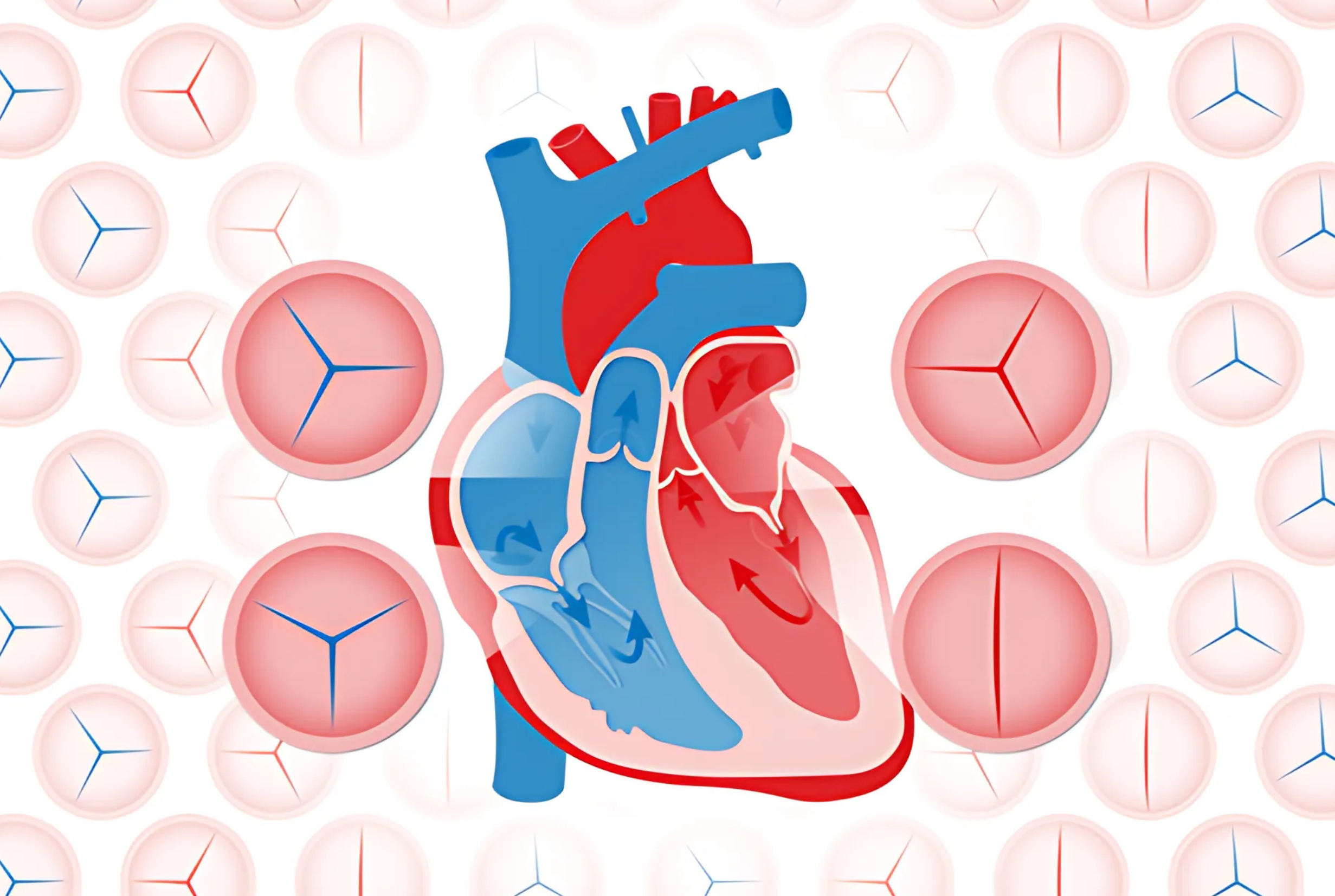Heart valve disease is a condition that affects the function of one or more of the heart’s valves, disrupting the flow of blood through the heart and potentially leading to serious complications like heart failure. This blog provides a comprehensive look at the causes, symptoms, and types of heart valve disease, such as regurgitation and stenosis. It also explores risk factors, including aging and underlying cardiovascular diseases, and emphasizes the importance of early diagnosis through physical exams and specialized heart tests. Treatment options range from medications and lifestyle changes to advanced surgical procedures like valve repair or replacement. Preventive measures, such as maintaining a heart-healthy lifestyle, are also discussed to help reduce the risk of developing heart valve disease.
Overview
Heart valve disease is a condition that affects the proper functioning of one or more of the heart’s four valves. These valves—mitral, tricuspid, aortic, and pulmonary—are responsible for ensuring the smooth flow of blood through the heart and into the rest of the body. When a heart valve is damaged, blood flow can be disrupted, leading to various health issues, including heart failure. Understanding heart valve disease is crucial for early detection, treatment, and prevention of serious complications. In this blog, we’ll explore the causes, symptoms, and treatment options available for this condition, as well as how it connects to broader cardiovascular disease.
The Heart Valves and Their Function
The heart has four valves—mitral, tricuspid, aortic, and pulmonary—that work like gates, ensuring blood flows in the right direction. These valves open and close with each heartbeat, regulating blood movement between the chambers of the heart and into the arteries. The smooth functioning of these valves is vital for maintaining healthy blood circulation. When any valve malfunctions, it can strain the heart, causing it to work harder to pump blood, eventually leading to heart valve disease and possibly heart failure if untreated.
Types of Heart Valve Problems
There are several types of heart valve problems, each affecting blood flow differently:
- Regurgitation (Backflow): In this condition, a valve doesn’t close properly, causing blood to flow backward. This often occurs in cases of valve prolapse, where the valve’s flaps (or leaflets) become floppy and bulge backward.
- Stenosis: Stenosis occurs when a valve becomes narrowed or stiff, preventing blood from flowing efficiently through it. Aortic valve stenosis is one of the most common forms, especially in older adults, and can lead to significant cardiovascular disease.
- Atresia: This is a rare congenital condition where a valve doesn’t form properly, and no opening exists for blood to pass through. It most commonly affects the pulmonary valve.
Understanding these different types of heart valve issues is key to knowing how they contribute to broader heart disease and cardiovascular disease.
Causes of Heart Valve Disease
Heart valve disease can be congenital (present from birth) or acquired over time. The causes vary widely:
- Congenital Causes: Some people are born with malformed heart valves, such as a bicuspid aortic valve instead of a normal tricuspid. These issues may not cause symptoms until later in life.
- Acquired Causes: Over time, heart valves can become damaged due to aging, infections, or underlying conditions. For example, rheumatic fever, caused by untreated strep throat, can damage the heart valves, leading to rheumatic heart disease. Other causes include endocarditis, an infection of the heart’s inner lining, and health conditions like high blood pressure and coronary artery disease.
Age-related wear and tear, combined with other cardiovascular risk factors, are leading causes of heart valve disease in older adults.
Risk Factors
Several factors can increase the likelihood of developing heart valve disease, including:
- Aging: As we age, our heart valves may calcify or become stiff, leading to stenosis or regurgitation.
- Medical history: Previous infections such as rheumatic fever or endocarditis can damage heart valves, increasing the risk of developing valve disease.
- Health conditions: High blood pressure, diabetes, and obesity are all risk factors for cardiovascular disease and can accelerate heart valve degeneration.
- Family history: A genetic predisposition to heart valve disease can also play a significant role.
- Lifestyle factors: Smoking, poor diet, and lack of exercise can increase the risk of developing both heart valve disease and broader cardiovascular disease.
Understanding these risk factors can help in the early detection and prevention of heart valve disease.
Symptoms of Heart Valve Disease
Heart valve disease may go unnoticed for years, as some patients remain asymptomatic until the condition progresses. When symptoms do appear, they often include:
- Shortness of breath: Especially during physical activity or when lying down.
- Fatigue: A feeling of constant tiredness, even with normal activities.
- Chest pain: A tight, squeezing sensation in the chest.
- Dizziness or fainting: Caused by insufficient blood flow to the brain.
- Swelling: Particularly in the legs, ankles, or abdomen due to fluid retention.
- Irregular heartbeat (arrhythmia): Palpitations or fluttering in the chest.
These symptoms are often signs of the heart struggling to maintain proper blood circulation, and they can lead to more severe conditions, such as heart failure.
Complications of Untreated Heart Valve Disease
When left untreated, heart valve disease can lead to several serious complications:
- Heart failure: This occurs when the heart cannot pump blood effectively, leading to fluid buildup in the lungs and other organs.
- Stroke: Irregular blood flow through the heart can cause blood clots, which may travel to the brain, resulting in a stroke.
- Blood clots: Improper blood circulation increases the risk of clot formation, which can block arteries and lead to serious cardiovascular events.
- Sudden cardiac arrest: In severe cases, untreated heart valve disease can result in sudden death due to the heart’s inability to function properly.
Early diagnosis and treatment are essential to avoid these life-threatening complications.
Diagnosis of Heart Valve Disease
If heart valve disease is suspected, a doctor will first perform a physical examination to listen for abnormal heart sounds, such as murmurs. If further evaluation is needed, patients may be referred to a cardiologist for additional tests, such as:
- Echocardiogram: A non-invasive test that uses sound waves to create images of the heart’s valves and chambers.
- Electrocardiogram (ECG): This records the heart’s electrical activity to detect abnormal rhythms.
- Cardiac catheterization: A procedure where a thin tube is inserted into a blood vessel to measure the heart’s pressure and flow.
These diagnostic tools help healthcare providers assess the severity of the valve problem and determine the appropriate treatment plan.
Treatment Options
The treatment for heart valve disease varies depending on the severity of the condition:
- Medications: While medications cannot cure heart valve disease, they can help manage symptoms. Common medications include diuretics (to reduce fluid retention) and beta-blockers (to lower heart rate and blood pressure). For patients at risk of blood clots, blood thinners may be prescribed.
- Lifestyle changes: Adopting a heart-healthy lifestyle is crucial. This includes eating a balanced diet, exercising regularly, quitting smoking, and managing conditions like high blood pressure and diabetes.
- Surgical options: For more severe cases, surgery may be required to repair or replace the damaged valve. Valve repair is often preferred as it carries fewer risks than replacement. However, in some cases, valve replacement with either mechanical or biological valves is necessary.
Recent advancements, such as Transcatheter Aortic Valve Replacement (TAVR), allow for minimally invasive treatment options, particularly for patients who may not be able to undergo traditional open-heart surgery.
Preventing Heart Valve Disease
While some causes of heart valve disease, such as congenital defects, cannot be prevented, many acquired forms can be avoided through healthy lifestyle choices:
- Maintain a heart-healthy diet rich in fruits, vegetables, whole grains, and lean proteins.
- Engage in regular physical activity to maintain cardiovascular fitness.
- Quit smoking and limit alcohol consumption.
- Manage chronic conditions such as high blood pressure, diabetes, and high cholesterol.
- Regular check-ups: This is especially important for individuals with a family history of heart valve disease or other cardiovascular conditions.
By making these changes, you can reduce the risk of developing both heart valve disease and other forms of cardiovascular disease.
A word from the Doctor-
Heart valve disease is a serious condition that can lead to heart failure and other life-threatening complications if left untreated. Understanding the symptoms, risk factors, and available treatments is crucial for maintaining heart health. Early diagnosis and intervention, combined with a heart-healthy lifestyle, can greatly improve outcomes. If you experience symptoms or have risk factors for heart valve disease, consult a healthcare professional for a proper evaluation and treatment plan.
So, get started by contacting us right away.

